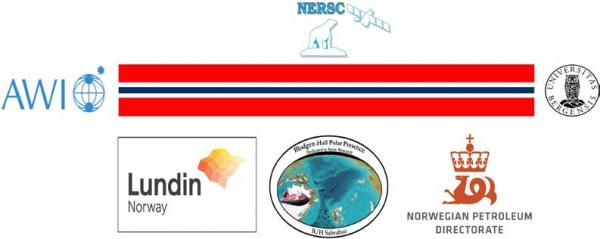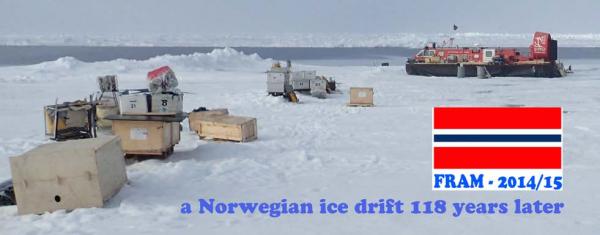
(29 June-12 July 2015)
Ice drift
The ice camp drifted 40 nautical miles (74 km) during the two first weeks (44 and 45) in July (Fig. 1). Only about half of that was towards the south. The camp is about 30 nautical miles away from the nearest land and 10 nautical miles away from the wedge of open water along the coast of Northeast Greenland. The surface air pressure has formed a relatively weak, but persistent high extending from Svalbard into the central Arctic Ocean and generated several periods of winds from the south and slowed the ice drift.
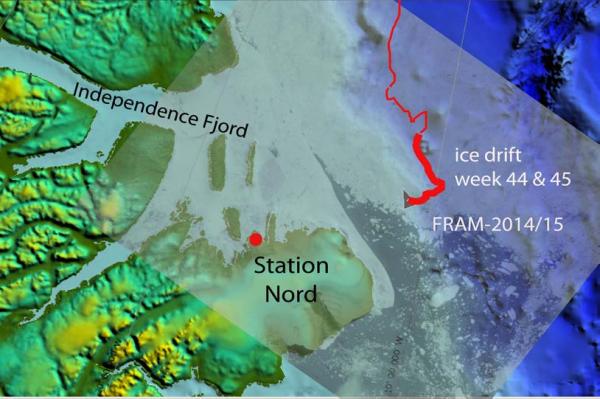
Fig. 1. The drift of FRAM-2014/15 during week 44 and 45, 29 June - 12 July 2015 ( thick red line). The satellite image (http://ocean.dmi.dk/arctic/images/MODIS/Nord/201507111311.jpg) courtesy of Danish Meteorological Institute shows the ice distribution and is draped over the bathymetry from the International Bathymetric Chart of the Arctic Ocean (IBCAO).
Sea ice dynamics
Local sea ice activity during the two weeks has been minor and probably mostly tidally driven variations in the width of leads already present. No ridging has occurred. We have moved from 15 to 6 and back to 10 nautical miles from the nearest open water. The satellite pictures show periods of considerable ice motion along the ice edge in addition to floes being discharged to free an unconstrained motion in open water.
Camp life
The past two weeks have been exceptional in that we had low clouds and reduced visibility for only 35% of the time, the rest has been a true pleasure. Camp life revolved around keeping the science going and taking measures to minimize the impact of the melting surface as well as keeping the food as cold as possible. During the southward drift, our site has also moved from 15 to 6 nautical miles away from the nearest open water. The ice cover in this area is largely a dense network of pressure ridges formed during the winter. Ice ridges represent obstacles to hovercraft driving, and to icebreakers. The surface expression of an ice ridge is called the "sail". Due to isostatic compensation, the keel depth of an ice ridge is more than four times the sail height and the width of the keel is 2-4 times the width of the sail. So, for a 2 meter high sail in an area of 2 meter thick level ice, you are considering a 10 meter thick local sea ice obstruction to an icebreaker. Most of the ridges in this area less than one hundred meters apart (Fig. 2), which for all practical purposes render the area inaccessible to diesel driven icebreakers given any reasonable effort. For this reason, patience is needed to ride out the last part in the life cycle of sea ice and we have opted for assistance in mid-August.
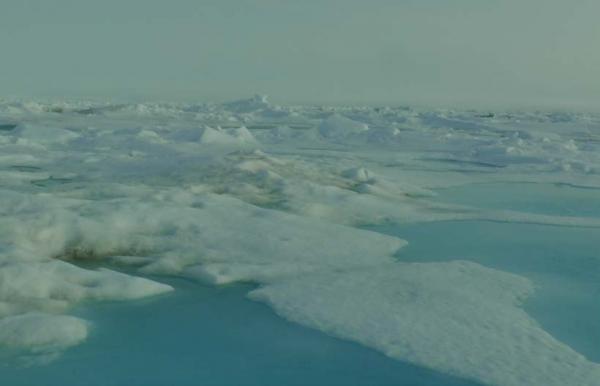
Fig. 2 The sea ice surface in front of the hovercraft at its present position
For several years, a plan to work on the ice covered coast and fjords of Northeast Greenland has been on our drawing board. A new research facility, the Villum Research Centre, established by University of
Aarhus at Station Nord was inaugurated 9 July by Her Majesty Queen Margrethe of Denmark. Northeast Greenland inside 3 nautical miles is a national park and any research activity is subject to permission by Greenland Authorities. The Villum Research Centre has on our behalf, submitted an application to the Greenland Authorities to enter the premises and operate in the Independence Fjord area during the interim period until the planned pick-up in mid-August. The objectives are to gain insight into hovercraft driving conditions over fjord ice, demonstrate the capabilities of a hovercraft research platform and carry out water depth measurements in the ice covered passage from the shelf to Station Nord. The capabilities to do oceanographic work and geological sampling are also present.
The initial plan for cruise PS 93.1 of the German research icebreaker Polarstern included a geological station c. 110 nautical miles to the south of the ice camp. The cruise took opportunity of favorable ice conditions and the grid of geological stations was moved to the north. The Captain and Chief Scientist visited the ice camp by helicopter on Sunday 5 July to familiarize themselves with the situation at the camp. An attempt followed to transfer the cargo from the ice camp to Polarstern by helicopter, but was aborted by mutual agreement due to various time constraints. The cargo transferred was limited to disposable dangerous goods such as used motor oil, batteries and ten empty fuel drums. Audun Tholfsen was granted permission to return to Norway onboard Polarstern .
At this point we are c. 27 nautical miles from nearest land on Nordostrundingen and c. 65 nautical miles from Station Nord. All the cargo in the ice camp has been placed up high on a former pressure ridge and tagged with two ARGOS satellite trackers and one tracker transmitting via Iridium (Fig. 3). The hovercraft is standing by about 4 nautical miles landward of the ice camp (Fig. 4) awaiting confirmation of a permission to enter the national park as well as improved ice conditions for passage to open water and Greenland.
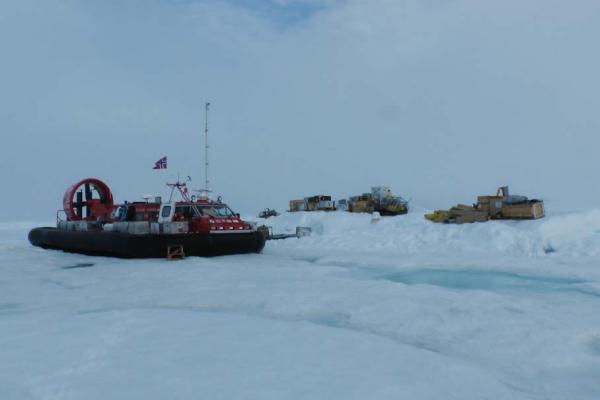
Fig. 3. The FRAM-2014/14 cargo (c. 2 ton) placed on top of a pressure ridge and tagged with three satellite trackers
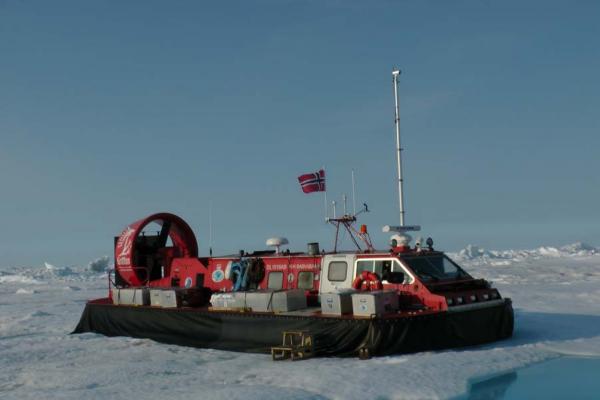
Fig. 4. The hovercraft on 12 July 2015. The ability to find an optimum path over the sea ice surface is much improved by a use of a camera on top a telescope mast (max. height 13 meter). The image from the "virtual bridge" is displayed on a laptop near the driver.
Science
Underway continuous measurements until end of week 44 of ice drift:
Bathymetry:
- Syquest echo box and autonomous data acquisition reporting via Iridium to CMR, Bergen
Atmosphere:
- measurement of incoming and outgoing radiation from the ice surface
- surface infrared skin temperature
- sun time
- Aanderaa weather station
Station work until end of week 44 of ice drift
- 4 CTD casts to 1000 meter depth
The science program on FRAM-2014/15 was terminated on Friday 3 July 2015 at the end of week 44 of ice drift. With the imminent disintegration of the sea cover ahead and limited available work force, we would like to be unconstrained by scientific duties on the drifting sea ice. During the interim period until a scheduled pick-up in mid-August, we hope to move the scientific activity to the adjacent Independence Fjord area of Northeast Greenland and work in cooperation with the new Villum Research Centre established by University of Aarhus.
In the ice camp, the radiation flux instrument and the weather station were dismantled and packed. All equipment items belonging to outside institutions go with the hovercraft, other items are stored in camp on an ice ridge marked with satellite trackers awaiting recovery in mid-August. The transducer of the bathymetry box was operated in the nearest lead. However, large pieces of ice were moving back and forth driven by tidal forces and often hit the buoy site. For this reason, we only kept the transducer in during day time. Now the buoy serves as a tracker of the cargo at the camp site.
Wild life
An Arctic tern is the only new bird species that was observed visiting the camp during the last two weeks
We had polar bear visits in camp seven days in a row starting at the beginning of week 44. The last one, a young bear was a bit aggressive, but eventually left. Days later, a seal was spotted on the ice.
Life in the High Arctic treats us well.
Yngve Kristoffersen & Audun Tholfsen
Daily reports
Monday 29 June
Position: 82° 25.14' N, 11° 04.7' W, temperature 0 °C, air pressure 1024 hPa, wind 3 knots from the SSE. Ice drift 0.1 towards SSE. A CTD cast was made to 1000 meter water depth. The azimuth of the hovercraft is now 144 degrees and was 141 degrees yesterday. Audun spotted an Arctic tern in camp. Received an e-mail from AWI-logistics which expressed their understanding that our contact so far had been to explore possibilities not asking for assistance . The cruise plan suggests a minimum separation of at least 100 nautical miles between the ship and the ice camp.
Tuesday 30 June
Position: 82° 25.00' N, 10° 54.3' W, temperature 0 °C, air pressure 1014 hPa, wind 10 knots from the SSW. Ice drift 0.2 knot towards E. Sun shine until the afternoon and overcast in the evening. A polar bear visited the camp. The bear appeared timid and kept at a distance. The animal was mostly interested in fish we had to dispose of. Responded to the e-mail from AWI-logistics that we did not anticipate their assistance would be needed considering the separation between the ship and the ice camp. The earlier alternative to use the sealer HAVSEL out of Longyearbyen in mid-August was reaffirmed with the owner.
Wednesday 01 July
Position: 82° 22.85' N, 10° 51.6' W, temperature 0 °C, 1017 hPa, wind 8 knots from the NW. Ice drift 0.2 knot to the S. Overcast, rain during the middle of the day. Made one CTD cast to 1000 meter water depth. The hovercraft azimuth is now 148 degrees. Had a polar bear around the camp all day. Audun sorted food and repacked. We had to take down the Norwegian flag which has been flying from the mast on top of the hovercraft since 30 August 2014, because the rope broke. A new flag was put in.
Thursday 02 July
Position: 82° 16.73' N, 10° 41.5' W, temperature -1 °C, air pressure 1021 hPa, wind 8 knots from the NNW. Ice drift 0.2 knot towards the S. Made a CTD cast down to 1000 meter depth. We moved cargo to the top of the pressure ridge that was formed by the destructive event in late March. This is considered the maximum safety to avoid being submerged as the summer melt progresses. A polar bear was walking around near the camp most of the day.
Friday 03 July
Position: 82° 14.08' N, 10° 35.3' W, temperature +4 °C, pressure 1023 hPa, wind 2 knots from the WSW. Ice drift 0.1 knot towards the SSE. The azimuth of the hovercraft was determined to 147 degrees from GPS measurements. At 0950 GMT the AWI Polar-5 aircraft was overhead and a brief contact was made. At 1800 hours, the data logging of the radiation flux instrument was terminated, and also for the weather station at 1915 hours (Norw. Summer time). All the equipment were dismantled and packed. Our remaining fuel is 45 liter of gasoline and 1600 diesel including Jet A-1. A polar bear was around in camp all day, being mostly interested in the food storage - had to scare the animal away several times.
Saturday 04 July
Position: 82° 13.57' N, 10° 27.8' W. Temperature +2 °C, air pressure 1026 hPa, wind 1 knot from the ENE. Ice drift 0.15 knot towards the SE. Polarstern was now at 81° 36' N, 06° 36' W. The cruise had taken advantage of the ice situation and moved the grid of geological stations to the north relative to the initial plan. An e-mail from Chief Scientist R. Stein informed us that there would be another geological station farther north and the Captain and the Chief Scientist would like to visit the ice camp by helicopter tomorrow morning. Had a shower in the sauna in the evening. A polar bear visited the camp during the night, but did not do any damage.
Sunday 05 July
Position: 82° 11.50' N, 10° 13.4' W, temperature +1 °C, air pressure 1029 hPa, wind 3 knots from the N. Ice drift 0.2 knot to the SE. Made a CTD cast to 1000 meter depth in the morning. Captain Wunderlich and the Chief Scientist arrived by helicopter at 1045 hours from a position about 11 nautical miles to the south of the ice camp. The purpose of the visit was to gather information about the situation at the ice camp for later consultation with the AWI logistics in Bremerhaven. From our standpoint, pick-up of the cargo would be a great help. The ice camp crew was invited for lunch on Polarstern . The return flight to the ice camp included two persons from Polarstern to assess the amount of cargo to be moved. The estimate was 12 helicopter trips. Later in the evening, we did away with all burnable waste in the camp and made the final preparations for cargo to be moved. A very aggressive polar bear appeared in the late evening, but was chased away.
Monday 06 July
Position: 82° 09.90' N, 09° 56.4' W, temperature +2 °C, air pressure 1027 hPa, wind 11 knots from the SSW. Ice drift 0.2 towards E. The Chief Mate and three of the Polarstern crew arrived by helicopter with equipment for cargo transfer. The priority was the disposable dangerous goods (used oil, batteries, empty fuel drums). Polarstern was now on station about 20 nautical miles to the west of the ice camp and each helicopter round trip was of the order of one hour. It became clear from consideration of the amount of cargo combined with flight crew work regulations that at least one extra day would be needed. This time would have to come out of the science time of a relatively short cruise, and it was agreed to terminate the attempted cargo transfer. Facing the prospect of another five weeks of slow drift and the summer go by, Audun asked to be transferred to Polarstern for return to Tromsø 18 July. Permission was granted by the parties involved, and the necessary document signed declearing that " RV Polarstern can proceed with her expedition according to vessels schedule and there are no further responsibilities from the side of the Master and Chief Scientist of RV Polarstern".
Tuesday 07 July
Position: 82° 07.80' N, 09° 44.2' W, temperature -1 °C, air pressure 1028 hPa, wind 8 knots from the E. Ice drift 0.1 knot towards S. Made a frame on port deck and put 1000 meter Kevlar line in. Reported to Polarstern with a summary of the past events.
Wednesday 08 July
Position: 82° 06.18' N, 09° 56.7' W, temperature -2 °C, 1028 hPa, wind 6 knots from the NE. Ice drift 0.1 knot to the SW. Activated two ARGOS trackers and the CMR buoy on the cargo stored on the pressure ridge, and started driving the hovercraft in the direction of Greenland. Had to stop after one hour because of vibrations when the propeller pitch is increased beyond 2/3 of full. Consulted with Griffon Hoverworks, UK, tightened the drive belt and continued. Got stuck on an ice ridge and had to winch out. At about midnight, we came into a very challenging area characterized by a mess of ice ridges and had to park. About 4 nautical miles had been covered.
Thursday 09 July
Position: 82° 03.05' N, 10° 22.0' W, temperature +2 °C, air pressure 1034 hPa, wind 7 knots from the NNW. Ice drift 0.1 knot towards SW. There is no sense in trying to proceed in this terrain due to the fuel consumption. The only alternative is to wait it out. Unfortunately the forecasted winds will remain from the south until Wednesday next week. Retightened the propeller drive belt and rearranged the utility box on the starboard side forward. Saw a seal on the ice basking in the sun at a distance.
Friday 10 July
Position: 82° 01.61' N, 10° 31.9' W, temperature +1 °C, pressure 1031 hPa, wind 7 knots from the SSE. Ice drift 0.1 knot towards the W. A beautiful day all the way through. Worked on | reports and made a reconnaissance trip on foot in the neighborhood.
Saturday 11 July
Position: 82° 01.52' N, 10° 49.5' W. Temperature 0 °C, air pressure 1027 hPa, wind 9 knot from the SE. Ice drift 0.1 knot towards the S. Worked on reporting.
Sunday 12 July
Position: 82° 26.83' N, 10° 47.8' W, temperature 0 °C, air pressure 1024 hPa, wind 4 knots from the N. Ice drift 0.15 knot to the S. Worked on reporting.
